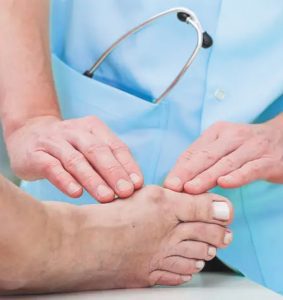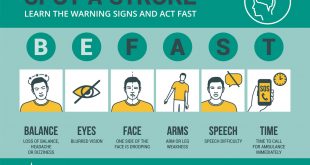By Premier Foot & Ankle Specialists


It is normal for everyone to have some uric acid in their body. However, when there is too much uric acid in the body, it leads to a condition called, hyperuricemia, which can, but does not always, cause gout. Uric acid buildup causing gout can occur via two methods. One, is an overproduction of the uric acid or two, is the underexcretion of uric acid by the kidneys. Uric acid is a byproduct of the breakdown of purines, a compound found in food and different cells of our bodies and is typically excreted in the form of urine. Therefore, either there is too much uric acid is in the body or not enough being efficiently excreted via urine, or a combination of both.
Gouty attacks can happen to anyone but most commonly to middle aged men in their 40-60’s. Some other risk factors include: obesity, certain medications like diuretics and beta blockers, stress, consuming sugary beverages, or foods with high levels of purines such as red meat, shell fish and alcohol. Diabetes, kidney disease and dehydration are also conditions that put you at increased risk for a gouty attack.
Gout symptoms can mimic other inflammatory disease, arthritis or even infection. Diagnosis may be difficult unless there is an active gouty attack. Seeing a trained podiatrist immediately during or right after your attack will help aid in your diagnosis. The doctor will ask a thorough set of questions regarding past medical history, lifestyle and diet. Typically, with a physical exam, x-rays will be taken and possibly a joint fluid test and or a blood test to determine the amount of uric acid in the blood stream.
Treatment of gout is essential to reduce the crystals in joints and lessen or prevent the breakdown of the joint which can cause arthritis and chronic pain. There is no cure of gout but there are treatments to manage symptoms and decrease the occurrence of flares. Some possible options for treatment include weight loss, exercise, physical therapy, limiting foods that trigger attacks, decreasing consumption of alcohol, drinking plenty of fluids to stay hydrated and help flush out excess uric acid. Anti-inflammatory medications, corticosteroids, or injections can help treat an acute attack. For patients with more frequent or chronic gout symptoms, medications to help lower uric acid in the blood are sometimes indicated, such as Allopurinol, Febuxostat, and Pegloticase.
Fortunately, gout can be successfully managed. If you believe you have experienced a gout flare, contact you podiatrist today to get treatment.
Dr. Brielle Roggow
Dr. Brielle Roggow was born and raised in Jackson, Minnesota. She attended and graduated from Minnesota State University, Mankato, with a Bachelor of Science in biology. Next, she moved to Cleveland, Ohio where she attended Kent State University of Podiatric Medicine and graduated in the top 10% of her class. Following medical school, she moved to Tampa, Florida where she completed her surgical residency with the James A. Haley Veterans Hospital.
Dr. Roggow is excited to provide exceptional foot and ankle care to Southwest Florida. Her podiatric interests include reconstructive surgery, wound care, trauma, and day-to-day podiatric care. Dr. Roggow enjoys spending her free time with her family. She is married to her husband Joshua and has a son, Jett, a daughter Josie, and two stepdaughters, Rylee and Reese. She enjoys being outdoors on the water, cooking, gardening, and riding horses.
Dr. Jeremy Bonjorno
Dr. Jeremy Bonjorno was born in Dansville, New York. He graduated from University of South Florida with a Bachelor of Science in Biomedical Sciences. Dr. Bonjorno received a Doctorate of Podiatric Medicine from Kent State University in Ohio. He completed a three-year surgical residency at the James A. Haley Veteran’s Hospital in Tampa, where he served America’s veterans.
Dr. Bonjorno is a community-focused podiatrist with a commitment to high-quality patient care. His podiatric interests include diabetic foot care, wound care, bunions, hammertoes, neuromas, and plantar fasciitis. In his free time, he enjoys spending time with his friends and family in Tampa. He also likes music, cars, traveling, and cycling.
Premier Foot & Ankle Specialists
(941) 488-0222
premierfootandanklefl.com
4120 Woodmere Park Blvd, Suite 5, Venice, FL 34293
 Southwest Florida's Health and Wellness Magazine Health and Wellness Articles
Southwest Florida's Health and Wellness Magazine Health and Wellness Articles

